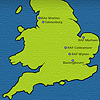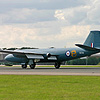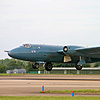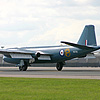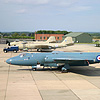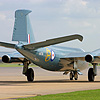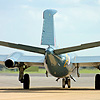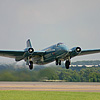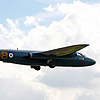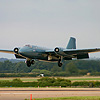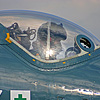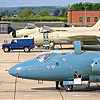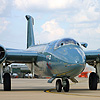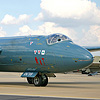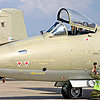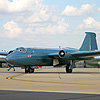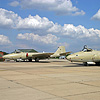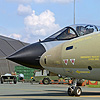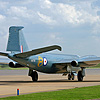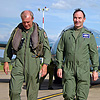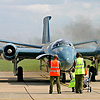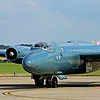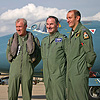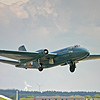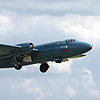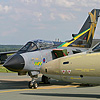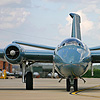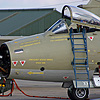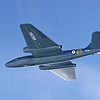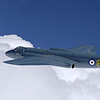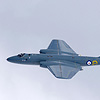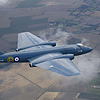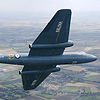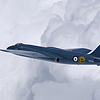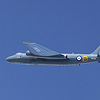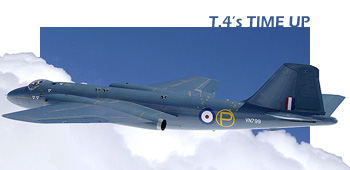
Canberra T.4 Retirement Feature Report
Thursday 1st September
You need a long memory to recall the days before the Royal Air Force operated the English Electric Canberra. Originally conceived as a replacement for the piston-engined Mosquito, Britain's first jet bomber made her maiden flight on May 13, 1949. That prototype, VN799, ushered in over half a century of loyal service from the jet. Indeed the Canberra has flown for a remarkable 60% of the time that mankind has known powered flight. Fitting then, that to mark the occasion of the RAF's retirement of the trainer variant, the sole T.4 still flying should wear the blue markings of the Canberra prototype.
visited RAF Marham on September 1, 2005 - the day of the aircraft's retirement after 51 years of service. Retirement day photography by the author, air-to-air photography .
She looked a picture. Sat on the 39 (1 PRU) Squadron apron at RAF Marham, Canberra T.4 WJ874 seemed blissfully unaware that this was to be the day her wings would be clipped.
The plan was for one final flight, to tour six locations key to the history of the aircraft: Bassingbourn, home to the original Canberra Operational Conversion Unit, RAF Wyton, a base synonymous with the type, as is RAF Cottesmore in Rutland. BAe Warton would be another venue to visit on the trip, as would the former English Electric works at Salmesbury near Preston, before returning to base at Marham, home of the RAF's last handful of operational Canberras.
WJ874's RAF career has been an incredibly long one. She was part of an order for T.4s placed in September 1950, and was ready for RAF collection on Christmas Eve, 1954. In her early days with the RAF, 874 'lived' at Wroughton, Binbrook and then Coningsby before moving to 231 OCU at Bassingbourn in August, 1961. She then went to Boscombe Down six years later, and then on to Aldergrove in 1969, before joining the Fleet Air Arm.
On November 12, 1969 WJ874 was assigned to Airwork Fleet Requirements at Bournemouth's Hurn Airport. She stayed with the Navy, coded as '847' and '848', later '858' until April 1986 when the aircraft re-joined the RAF.
It was a case of renewing old acquaintances - 874 rejoined 231 OCU at RAF Wyton where she took up the code 'BM' up until the OCU's disbandment in 1993. She briefly transferred to 360 Squadron at Wyton before coming to 39(1 PRU) Squadron at Marham in 1994 to be rotated in and out of training service with the rest of the RAF's dwindling band of T.4s. In 1999 she returned to Hurn for a new coat of paint to mark the 50th anniversary of the type's first flight, and re-emerged as she is today - in the colour scheme of the Canberra prototype VN799. Since then she's been providing crew training for 39 (1 PRU) Squadron aircrew, though experienced crews generally only need a couple of T.4 sorties each year.
On a gloriously warm early September afternoon, WJ874 accelerated down Marham's long runway for one final time. Rotating before the bank of aviation press photographers, she climbed away with her highly polished blue wings reflecting the bright sunshine. She completed her final sortie as planned. "Excellent" was how her pilot, Squadron Leader Terry Cairns, described it. On board with Squadron Leader Cairns was Wing Commander Clive Mitchell, Officer Commanding 39 (1 PRU) Squadron, along with Air Vice-Marshal Andy White, Air Officer Commanding 3 Group.
Less than two hours after take off she returned to Marham. One touch and go before finally slowing to taxi back to face the waiting media, for this was a part of RAF history. A history in which the Canberra's name and service record will be writ large.
"I'm going to be quite sad", said Wing Commander Mitchell. "You have to remember that we've only had powered flight for just over 100 years - and the Canberra has flown for nearly 60% of that time. By any measure that's some record."
Air Vice-Marshal White said: "I'm very proud that we in the RAF introduced the Canberra way back in 1949. It was our first jet bomber. It was a great design, and we've kept the Canberra going all this time."
But why is the Canberra being retired? She's still a more than capable photo-reconnaissance platform; indeed the United States Air Force often cast envious eyes towards her. The Canberra may not fly at the altitude of the U-2, but in many ways, and in spite of her years, the old campaigner offers much more flexibility. That's certainly the view of Flight Lieutenant Ernie Taylor - a man who will pass into Canberra lore as the last RAF pilot to qualify on the aircraft: "The U-2 is very 'pre-planned' - if there's cloud over a reconnaissance target, the aircraft can't reposition to come at it from a second angle. The Canberra can. People have this misconception that we fly at 50,000ft. We don't - and that's probably the reason why the aircraft is so flexible in the role."
Flight Lieutenant Taylor is relatively new to the Canberra and will miss her when the time comes to retire the remaining photo-reconnaissance PR.9 variants: "There was never going to be a Canberra replacement. A lot of what we do, other aircraft simply can't, so there will be a capability gap, rather like at the time of the Falklands conflict when we got rid of the [Fairey] Gannets."
Looking after a 50-year-old jet isn't as difficult as you think. Corporal Dale Windle is part of the team that maintains 39 (1 PRU) Squadron's fleet and says the aircraft may be old, but their relatively simple construction compared to more modern machines, means keeping them in the air isn't too much of a problem: "They're well-made. It's as simple as that. There's not too much on a Canberra to go wrong, and if and when it does, it's easy to fix."
Corporal Windle's relatively new to 39 (1 PRU) Squadron - but always wanted to work on the Canberra, for sentimental reasons: "My uncle worked on Canberras before me, so the aircraft is special to me. I'm glad that I'll have been here to work on them for the final two-and-a-half years."
The PR.9 fleet will soldier on until next summer (2006), but with the retirement of the last of the T.4s (a second was lost in a fatal landing accident at Marham in September 2004), the type's days are most definitely numbered.
What does the future hold for WJ874 then? Though September 1, 2005 was her final flight in RAF service, it's not inconceivable she might again have air beneath her wings - be that for a ferry flight to a museum, or on the air display circuit in civilian hands. With the jet currently 'up for disposal' - Ministry of Defence speak for 'for sale' - those connected with the Canberras at Marham reckon she should be preserved.
Wing Commander Mitchell believes that sourcing spare parts for the venerable machine could be the only barrier preventing 874 extending her flying life on Civvy Street: "There's no reason why she shouldn't fly on in civilian hands. The only major problem I can see is the same one we have - spares. This aircraft has different engines to the Air Atlantique Canberra [WK163 - the only Canberra flying in civilian hands in the UK]. They're [Rolls-Royce] Avon Mark Ones, and getting spares is very difficult."
A view shared by Squadron Leader Cairns: "I'd love to see her go to a museum, or better still fly with one of the companies who operate classic jets. The engines on her might be a problem. There aren't many of the Avon Mark Ones left."
Time will tell what becomes of WJ874. Would there be sufficient interest from airshow organisers to allow her to be profitably operated outside the RAF? Should the RAF expand its own 'in-house' fleet of historics, in the shape of the Battle of Britain Memorial Flight? Could the T.4 have a 'working' retirement with a company like Hawker Hunter Aviation at Scampton? Plenty of questions are left to be answered, but the situation is that the aircraft is up for sale. There is, of course, a chance that the only bidders might be scrap metal merchants - and that would be a tragedy if that were to be the case.
The Canberra story isn't quite at an end yet, the PR.9s still have a few months service left to give, and numerous examples operate in civilian hands around the world, and there'll be plenty of enthusiasts hoping that the final touchdown at Marham on September 1, 2005 wasn't the end of T.4 WJ874's flying career, but merely the end of a chapter, albeit one spanning an incredible 51 years.

